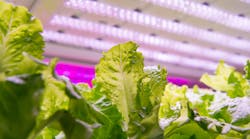Indoor growing facilities are on the rise. Fueled by consumers’ demand for locally-produced food, as well as legalized medical and/or recreational cannabis cultivation in many states, projections show the US controlled environment agriculture (CEA) market is predicted to hit $3 billion this year, with annual growth of about 24 percent.
Although CEA uses less space and can produce higher yields than traditional agriculture, a January 2024 US Department of Agriculture study noted that “the primary concern of indoor farms is the energy cost, specifically the lighting needed to grow crops.” Horticultural lighting is one of the fastest growing segments of the electric load for many utilities, prompting the US Department of Energy to recommend that the nation’s growers transition their lighting to all LED technology, which would cut electricity usage by 34 percent and costs by approximately $350 million annually.
In line with its mission to reduce energy use, carbon emissions, and light pollution through quality lighting and controls, the DesignLights Consortium (DLC) has implemented Horticultural Lighting Technical Requirements that promote energy efficient technology in CEA facilities. The more than 1,500 LED fixtures (from over 200 manufacturers) on the DLC’s Horticultural Qualified Products List (QPL) are over 35 percent more efficient than the next-best option, the 1000W double-ended high pressure sodium luminaire.
When selecting lighting products for horticultural applications, it’s important to note that not all LEDs are created equal. Like other LED fixtures, LEDs intended specifically for horticulture do curb energy use and carbon emissions, but they also meet UL standards for safety issues unique to horticultural environments. Because lighting is an integral part of the crop growing process, fixtures manufactured for CEA must emit light that falls within the photosynthetically active radiation (PAR) wavelengths conducive to effective plant growth and take into account specific spectral effects that vary by individual crop. Plant canopy height within the facility and compatibility with HVAC and shading systems to meet overall temperature and humidity needs, as well as unintentional light pollution from greenhouse lighting, are among additional considerations.
In general, requirements for horticultural lighting involve more rigorous testing and standards than are required for typical LEDs. The DLC’s Horticultural QPL takes the guesswork out of finding luminaires that meet these criteria. Because inclusion on the DLC’s Horticultural QPL requires third-party testing and reporting processes to validate conformity with UL safety standards and performance criteria - including energy efficiency, growers and their lighting decision makers can be sure that luminaires on the list are not just safe and efficient, but also eligible for valuable utility rebates. When Version 3 of the DLC’s Horticultural Technical Requirements takes full effect later this year, the QPL will display additional useful information on the specific type of CEA application the listed fixtures are intended for, as well as controllability information, dimensions and product images.
For more information about horticultural lighting, check out this video and other resources on the DLC’s website. To peruse the QPL, just create a free MyDLC account and log on.





